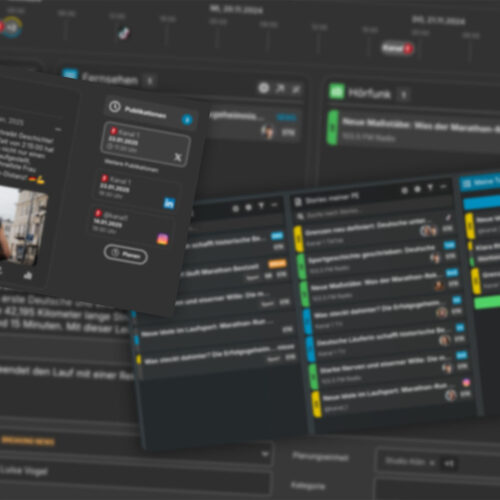Given the growing number of new market players and the resulting increase in competitive pressure, new demands from readers and listeners, new innovations and rising costs, it is becoming increasingly difficult for media and editorial teams to place their stories successfully. Not only when it comes to the audience, but also within the economic framework. And that means that without good management, even the best story will not reach its destination. This is where editorial management or media management comes into play, centered on resources, the market and the target group. But how do those responsible manage an editorial office in an economically orientated way, but also with people such as the target group and employees in mind? What tasks are involved in editorial management and which tools can help? We take a closer look at how editorial teams produce good content while also knowing how this content is received and how they can best utilize their resources.

Contents of this page
Definition of editorial management:
A simple explanation
Put simply, editorial management ensures that everything runs smoothly and purposefully – from topic planning to publication. Good editorial management ensures that teams have the right topics at the right time and coordinates that everyone works well together and produces efficiently. Media management, project management and program management go hand in hand to increase revenue and reduce costs.
This also shows that good editorial management is not possible without figures and controlling in order to achieve editorial goals and promote quality in journalism. Journalism schools offer suitable courses such as “Entrepreneurial Journalism”.
But editorial management is not just for journalism. Other online editorial teams or internal communication and marketing departments in companies can also learn something from the specialist sector in this area: after all, every company needs efficient processes when working with content and media. It doesn’t matter whether the organizational structure is hierarchical or not: editorial and media management is important for everyone.
What is the difference to media management?
Media management and editorial management are closely linked and are often used in parallel. However, some sources differentiate between the journalistic focus: editorial management can refer more to the organization and coordination of editorial content within a media company. The focus is on aspects such as topic planning and the strategic orientation of products or formats.
If media management is to be distinguished from editorial management, then it often encompasses the entire management of a media company and also focuses on media business management, including financial management or even sales.
But whether editorial management or media management: both terms complement each other and promote a strategic orientation that is becoming more decisive in today’s pressure to innovate and compete in the entire media industry.
Tasks: Editorial management is multi-layered
Im Redaktions- und Medienmanagement gibt es eine Reihe von verschiedenen Stellschrauben und Aufgaben, um die Ziele einer Redaktion zu erreichen. Sie können in der Verantwortung eines Redaktionsleiters oder des Abteilungsleiters liegen, aber da immer mehr Redaktionen hierarchiefrei organisiert sind, können auch andere Rollen oder ganze Teams die Aufgaben übernehmen:
- Team leadership and motivation: Leading and supporting the editorial team. Everyone should contribute their strengths.
- Team development: setting yourself up for the future, promoting and developing teams.
- Topic planning and coordination: Ensuring that the right topics are dealt with at the right time.
- Innovative product development: Creating relevance but also developing business models to monetize media offerings.
- Quality control: Checking that content meets journalistic standards.
- Time and resource management: coordinating the deployment of media professionals, setting and meeting deadlines.
- Crisis management: reacting quickly to unexpected events and finding solutions.
- Measuring success: Use data to understand target groups as well as performance, and use this knowledge to make better decisions and act accordingly.
- Media controlling: Conceptual and instrumental support for the management of media companies by monitoring budgets, income, costs, etc., but also the competition.
- Communication: Talk to different departments, such as sales, marketing and engineering, to make sure everyone is on the same page.
Above all, editorial management must ensure that the strategy and operational tasks fit together. The transfer into practice is important. Data and statistics help to see which topics are well received and which formats help to achieve the goals – and which do not. Only data-based work makes it possible to continuously improve content and organization and identify trends early on.
By the way: Other things can also fall under the term “editorial management” in some companies. Like the office management of an editorial office, such as processing letters from readers or coordinating appointments for the editor-in-chief or business trips.
Why editorial management?
What are the goals of editorial management? It may already be clear from the definition and tasks listed. But let’s summarize the goals of effective editorial management and why it is important:
- Efficiency in the creation process
- Saving costs
- Securing and raising income
- Optimally reaching target groups
- Better organized everyday editorial work
- Implementing strategy
Managing and organizing an editorial team helps to optimize processes, formulate goals and identify gaps. If you approach editorial management correctly, you can link the overarching strategy with operational work and achieve results.
Which methods and tools to use for media organisation?
In order to work effectively and agilely, modern editorial offices rely on a variety of tools and frameworks that support them in editorial and media management and optimize their work. Here are a few examples of tools and methods for organizing editorial teams:
Strategy frameworks
Strategy frameworks are essential in editorial management in order to structure both the long-term direction and the daily work processes. They can provide clarity on how goals can be set and achieved. One of the best-known frameworks for many companies in numerous industries is the SWOT analysis framework. It helps to identify strengths, weaknesses, opportunities and risks and to develop a well-founded strategy – also in media companies. Another useful tool is the Business Model Canvas: it makes business models visually analyzable.

Management tools
Editorial managers who want to encourage and motivate their teams should make use of various management tools. Above all, regular and constructive feedback is crucial for the further development of employees and the optimization of work processes. This is where 360-degree feedback comes into play, for example, which involves all opinions and promotes an open feedback culture. Perhaps this will bring completely new ideas and innovations to light? One-on-one meetings are also important for discussing individual concerns and setting personal development goals.
OKRs (Objectives key results)
OKRs are a proven tool in strategic management. They help to define clear and measurable goals (objectives) and identify the steps (key results) that are necessary to achieve these goals. This not only creates clarity, but also helps to prioritize important tasks. In practice, an OKR set typically looks like this: An objective could be to increase the magazine’s reach, while the key results define the specific measures and their metrics, such as a 20% increase in subscribers or a doubling of social media interactions. This is where the team can get even more granular: How do we increase subscribers or interactions? What measures are needed to achieve this?

Media could thus create a pyramid of objectives for their offers and formats based on the objectives and key results method and recognize more quickly how the lower levels contribute to the upper levels.
In this way, OKRs bring the various departments together optimally and enable joint strategy development. They therefore create transparency and a common understanding of goals, which in turn strengthens cooperation and team spirit.
Media performance KPIs
Key performance indicators (KPIs) are helpful for evaluating the success of an editorial team, i.e. to see whether the work is worthwhile. Typical KPIs in the media industry can include metrics such as page views, reach, video views, watch time, bounce rate, subscriber numbers and social media engagement. Such KPIs provide valuable insights into the effectiveness of the content and the preferences of the target group. By monitoring them, editorial teams can identify trends, adapt their strategies and also optimize their content according to the target group in order to achieve their goals.
Monitoring tools
So how do media companies obtain the data and KPIs? They need monitoring tools that enable real-time analysis and long-term evaluation of editorial performance. Google Analytics, for example, is widely used in many industries to understand web traffic and user behavior. Social media platforms such as Facebook, Instagram and TikTok also offer their own analysis tools that can be accessed directly via the systems. Chartbeat, on the other hand, offers publishers in particular real-time data and detailed insights into reader engagement. Ideally, however, media companies combine their data across different media in order to draw the right conclusions across all channels. This is possible with analysis platforms for the media industry that directly integrate numerous sources and thus enable holistic monitoring.
Digital newsrooms
Digital newsrooms are platforms that make communication and collaboration within an editorial team more efficient. They enable the centralised management and control of content and promote transparency and coordination between different teams.
The digitalisation and process optimisation of editorial offices also supports editorial management. Because if you want to produce content successfully today, you have to change the way you work together with digital processes, transparent communication and structures that grow with you. What can this look like? Read the free strategy paper now.

How do editorials combine strategy with operative work?
An effective media organisation must seamlessly link strategy and operational work. Here is where the coordination and information function of data analytics and controlling comes into play. In other words, collecting data is not enough. You have to pick up the data where it is generated and, in addition to efficient data collection (in high quality) and analysis, you also need to feed the findings back to the content teams.
- How did the topics perform?
- Which products perform well? Across all touch points?
- Will we reach our golas this way?
For day-to-day work in editorial offices, this means that teams need to establish a “data culture” with cross-functional teams and coordinate properly. This requires an iterative process between data analysts and editors, for example, before, during and after productions in order to continuously adapt and optimize strategies.

The interaction with topic planning is particularly important here. By recognising which topics have performed successfully, editorial teams can better tailor their content to the interests and needs of their target group. This data-supported approach leads to a more targeted selection of topics and more efficient editorial work overall.
Tip: Combine all data in one software
The best way to proceed iteratively is by not looking at cross-media data and content separately. Digital platforms play a decisive role here, seamlessly linking editorial work with important data – whether from social media, radio or podcasts.
An example for effective editorial management:
A centralised access to all information is provided, for example, by the Newsmind Stories editorial system in combination with the Newsmind Spectrum analysis platform. In such an editorial system, the focus is on joint, topic-centred planning and publishing – for all channels. At the same time, audience data is automatically collected on a daily basis, can be analysed and linked directly to the content. This comprehensive data integration into daily content work provides a clear overview and makes it possible to precisely measure the success of different content.
More interesting articles that you shouldn’t miss




